Hesperornis
| Hesperornis Temporal range: Late Cretaceous, 83.5–78 Ma | |
|---|---|
.jpg) | |
| Restored skeleton of H. regalis | |
| Scientific classification | |
| Kingdom: | Animalia |
| Phylum: | Chordata |
| Class: | Reptilia |
| Clade: | Dinosauria |
| Order: | Saurischia |
| Suborder: | Theropoda |
| Clade: | †Hesperornithes |
| Family: | †Hesperornithidae |
| Genus: | †Hesperornis Marsh, 1872 |
| Type species | |
| †Hesperornis regalis Marsh, 1872 | |
| Species | |
|
†H. regalis Marsh, 1872 | |
| Synonyms | |
|
Lestornis Marsh, 1876 | |
Hesperornis (meaning "western bird") is a genus of flightless aquatic birds that spanned the first half of the Campanian age of the Late Cretaceous period (83.5–78 mya). One of the lesser-known discoveries of the paleontologist O. C. Marsh in the late 19th century Bone Wars, it was an early find in the history of avian paleontology. Locations for Hesperornis fossils include the Late Cretaceous marine limestones from Kansas and the marine shales from Canada. Nine species are recognised, eight of which have been recovered from rocks in North America and one from Russia.
Description

Hesperornis was a large bird, reaching up to 1.8 metres (5.9 ft) in length.[2] It had virtually no wings, and swam with its powerful hind legs. Fossil evidence shows that the toes were probably lobed, as in today's grebes, rather than webbed as in those of loons.
Like many other Mesozoic birds such as Ichthyornis, Hesperornis had teeth as well as a beak, which were used to hold prey. In the hesperornithiform lineage they were of a different arrangement than in any other known bird (or in non-avian theropod dinosaurs), with the teeth sitting in a longitudinal groove rather than in individual sockets, in a notable case of convergent evolution with mosasaurs.[3][4] The teeth of Hesperornis were present along nearly the entire lower jaw (dentary) and the back of the upper jaw (maxilla). The front portion of the upper jaw (premaxilla) and tip of the lower jaw (predentary) lacked teeth and were probably covered in a beak. Studies of the bone surface show that at least the tips of the jaws supported a hard, keratinous beak similar to that found in modern birds.[5] The palate (mouth roof) contained small pits that allowed the lower teeth to lock into place when the jaws were closed.[6] They also retained a dinosaur-like joint between the lower jaw bones. It is believed that this allowed them to rotate the back portion of the mandible independently of the front, thus allowing the lower teeth to disengage.[2]
History
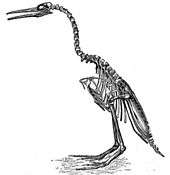
The first Hesperornis specimen was discovered in 1871 by Othniel Charles Marsh. Marsh was undertaking his second western expedition, accompanied by ten students.[7] The team headed to Kansas where Marsh had dug before. Aside from finding more bones belonging to the flying reptile Pteranodon, Marsh discovered the skeleton of a "large fossil bird, at least five feet in height". The specimen was large, wingless, and had strong legs—Marsh considered it a diving species. Unfortunately, the specimen lacked a head.[8] Marsh named the find Hesperornis regalis, or "regal western bird".[9]
Marsh headed back west with a smaller party the following year. In western Kansas, one of Marsh's four students, Thomas H. Russell, discovered a "nearly perfect skeleton" of Hesperornis.[10] This specimen had enough of its head intact that Marsh could see that the creature's jaws had been lined with teeth.[11] Marsh saw important evolutionary implications of this find, along with Benjamin Mudge's find of the toothed bird Ichthyornis.[12] In an 1873 paper Marsh declared that "the fortunate discovery of these interesting fossils does much to break down the old distinction between Birds and Reptiles".[11] Meanwhile, Marsh's relationship with his rival Edward Drinker Cope soured further after Cope accidentally received boxes of fossils, including the toothed birds, that were meant for Marsh. Cope called the birds "simply delightful", but Marsh replied with accusations Cope had stolen the bones.[13] By 1873 their friendship dissolved into open hostility, helping to spark the Bone Wars. While Marsh would rarely go into the field after 1873, the collectors he paid continued to send him a stream of fossils. He eventually received parts of 50 specimens of Hesperornis, which allowed him to make a much stronger demonstration of an evolutionary link between reptiles and birds than had been possible before.[14]
Classification and Species
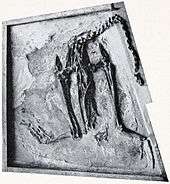
Many species have been described in this genus, though some are known from very few bones or even a single bone and cannot be properly compared with the more plentiful (but also incomplete) remains of other similar-sized taxa. In many cases, species have been separated by provenance, having been found in strata of different ages or in different locations, or by differences in size.
The first species to be described, the type species, is Hesperornis regalis. H. regalis is also the best known species, and dozens of specimens (from fragments to more complete skeletons) have been recovered, all from the Smoky Hill Chalk Member of the Niobrara Formation (dating to the early Campanian age, between 83.5–80.5 million years ago).[15] It is the only species of Hesperornis for which a nearly complete skull is known.
Hesperornis crassipes was named in 1876 by Marsh, who initially classified it in a different genus as Lestornis crassipes. H. crassipes was larger than H. regalis, had five ribs as opposed to four in the first species, and differed in aspects of the bone sculpturing on the breastbone and lower leg. H. crassipes is known from the same time and place as H. regalis. One incomplete skeleton is known, including teeth and parts of the skull.[16]
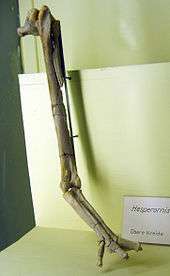
Marsh explicitly named his second species of Hesperornis in 1876 for an incomplete metatarsus recovered from the same layers of the Niobrara chalk as H. regalis. He named this species H. gracilis, and it was subsequently involved in the rather confused taxonomy of a specimen which would eventually form the basis of the new genus and species Parahesperornis alexi. The type specimen of P. alexi was assumed to belong to the same specimen as that of H. gracilis, so when Lucas (1903) decided that the former specimen represented a distinct genus, he mistakenly used the later specimen to anchor it, creating the name Hargeria gracilis. This mistake was rectified by later authors, who sank Hargeria back into Hesperornis and renamed the more distinctive specimen Parahesperornis.[17]
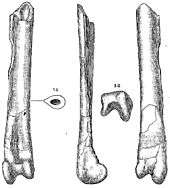
The first species recognized from outside the Niobrara chalk, Hesperornis altus, lived about 78 million years ago in Montana, and is known from a partial lower leg from the base of the freshwater Judith River Formation (or, possibly, the top of the underlying, marine Claggett Shale formation). While initially placed in the new genus Coniornis by Marsh, this was due mostly to his belief that Hesperornis existed only in Kansas, so any species from Montana should be placed in a different genus. Most later researchers disagreed with this, and have placed Coniornis altus in the same genus as Hesperornis as H. altus.[18][19] A second species from Montana has also been described from the Claggett Shale. H. montana was named by Shufeldt in 1915, and while its known material (a single dorsal vertebra) cannot be directly compared to H. altus, Shufeldt and others have considered it distinct due to its apparently smaller size.[20]
In 1993, the first Hesperornis remains from outside of North America were recognized as a new species by Nessov and Yarkov. They named Hesperornis rossicus for a fragmentary skeleton from the early Campanian of Russia near Volgograd. Several other specimens from contemporary deposits have since been referred to this species. At about 1.4 metres (4.6 ft) long, H. rossicus was the largest species of Hesperornis and among the largest hesperornithines, slightly smaller than the large Canadian genus Canadaga.[9] Aside from its large size and different geographic location, H. rossicus differs from other Hesperornis in several features of the lower leg and foot, including a highly flattened metatarsus.[21]
In 2002, Martin and Lim formally recognized several new species for remains that had previously been unstudied or referred without consideration to previously named North American hesperornithines. These include the very small H. mengeli and H. macdonaldi, the slightly larger H. bairdi, and the very large H. chowi, all from the Sharon Springs member of the Pierre Shale Formation in South Dakota and Alberta, 80.5 million years ago.[22]
In addition, there are some unassigned remains, such as SGU 3442 Ve02 and LO 9067t and bones of an undetermined species from Tzimlyanskoe Reservoir near Rostov. The former two bones are probably H. rossicus; some remains assigned to that species in turn seem to belong to the latter undetermined taxon.[23] The small form, initially called H. gracilis, was later moved into a monotypic genus Hargeria, and ultimately placed in Parahesperornis.[24]
Paleobiology
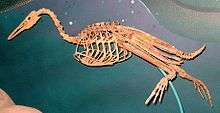
Hesperornis was primarily marine, and lived in the waters of such contemporary shallow shelf seas as the Western Interior Seaway, the Turgai Strait, and the North Sea,[23][25] which then were subtropical to tropical waters, much warmer than today. However, some of the youngest known specimens of Hesperornis have been found in inland freshwater deposits of the Foremost Formation, suggesting that some species of Hesperornis may have eventually moved, at least partially, away from a primarily marine habitat. Additionally, the species H. altus comes from the freshwater deposits at the base of the Judith River Formation.[26]
Traditionally, Hesperornis is depicted with a mode of locomotion similar to modern loons or grebes, and study of their limb proportions and hip structure has borne out this comparison. In terms of limb length, shape of the hip bones, and position of the hip socket, Hesperornis is particularly similar to the common loon (Gavia immer), probably exhibiting a very similar manner of locomotion on land and in water. Like loons, Hesperornis were probably excellent foot-propelled divers, but ungainly on land.[27] Like loons, the legs were probably encased inside the body wall up to the ankle, causing the feet to jut out to the sides near the tail. This would have prevented them from bringing the legs underneath the body to stand, or under the center of gravity to walk. Instead, they likely moved on land by pushing themselves along on their bellies, like modern seals.[28]
Young Hesperornis grew fairly quickly and continuously to adulthood, as is the case in modern birds, but not Enantiornithes.[29]
Pathology
A Hesperornis leg bone uncovered in the 1960s was examined by David Burnham, Bruce Rothschild et al. and was found to bear bite marks from a young polycotylid plesiosaur (possibly a Dolichorhynchops or something similar). The Hesperornis's bone, specifically the condyle, shows signs of infection, indicating the bird survived the initial attack and escaped the predator. The discovery was published in the journal Cretaceous Research in 2016.[30]
References
- ↑ Keiichi Aotsuka; Tamaki Sato (2016). "Hesperornithiformes (Aves: Ornithurae) from the Upper Cretaceous Pierre Shale, Southern Manitoba, Canada". Cretaceous Research. in press. doi:10.1016/j.cretres.2016.03.003.
- 1 2 Perrins, Christopher (1987) [1979]. Harrison, C.J.O., ed. Birds: Their Lifes, Their Ways, Their World. Pleasantville, NY, US: Reader's Digest Association, Inc. pp. 165–166. ISBN 0895770652.
- ↑ Marsh, Othniel Charles (1880): Odontornithes, a Monograph on the Extinct Toothed Birds of North America. Government Printing Office, Washington DC.
- ↑ Gregory, Joseph T. (1952). "The Jaws of the Cretaceous Toothed Birds, Ichthyornis and Hesperornis" (PDF). Condor. 54 (2): 73–88. doi:10.2307/1364594. JSTOR 1364594.
- ↑ Heironymus, T.L.; Witmer, L.M. (2010). "Homology and evolution of avian compound rhamphothecae" (PDF). The Auk. 127 (3): 590–604. doi:10.1525/auk.2010.09122.
- ↑ Elzanowski, A. (1991). "New observations on the skull of Hesperornis with reconstructions of the bony palate and otic region". Postilla. 207: 1–20.
- ↑ Thomson, 191.
- ↑ Thomson, 193.
- 1 2 Holtz, Thomas R. Jr. (2011) Dinosaurs: The Most Complete, Up-to-Date Encyclopedia for Dinosaur Lovers of All Ages, Winter 2010 Appendix.
- ↑ Charles Schuchert and Clara Mae LeVene, O.C. Marsh: Pioneer in Paleontology, p. 427. New York: Arno Press, 1978. Later, Russell assisted Marsh while attending medical school; he became a surgeon, professor of Clinical Surgery in the Yale School of Medicine, and Marsh's personal physician until Marsh's death in 1899. See Proceedings of the Connecticut State Medical Society (Google eBook) and Genealogical and Family History of the State of Connecticut: A Record of the Achievements of Her People in the Making of a Commonwealth and the Founding of a Nation. Editorial staff: William Richard Cutter, Edward Henry Clement, Samuel Hart, Mary Kingsbury Talcott, Frederick Bostwick, Ezra Scollay Stearns. Volume I (of 4). New York: Lewis Historical Publishing Company, 1911.
- 1 2 Wallace, 86.
- ↑ Thomson, 226.
- ↑ Wallace, 87.
- ↑ Wallace, 132.
- ↑ Carpenter, K. (2003). Harries, P. J, ed. "Vertebrate Biostratigraphy of the Smoky Hill Chalk (Niobrara Formation) and the Sharon Springs Member (Pierre Shale)". High-Resolution Approaches in Stratigraphic Paleontology. Topics in Geobiology. 21: 421–437. doi:10.1007/978-1-4020-9053-0. ISBN 978-1-4020-1443-7.
- ↑ Marsh, O.C. (1876). "Notice of new Odontornithes". The American Journal of Science and Arts. 11: 509–511.
- ↑ Bell, A.; Everhart, M.J. (2009). "A new specimen of Parahesperornis (Aves: Hesperornithiformes) from the Smoky Hill Chalk (Early Campanian) of Western Kansas". Transactions of the Kansas Academy of Science. 112 (1/2): 7–14. doi:10.1660/062.112.0202.
- ↑ Shufeldt, R.W. (1915). "Fossil birds in the Marsh Collection of Yale University". Transactions of the Connecticut Academy of Arts and Sciences. 19: 1–110.
- ↑ Martin, L.D. (1984). "A new hesperornithid and the relationships of the Mesozoic birds". Transactions of the Kansas Academy of Science. 87 (3/4): 141–150. doi:10.2307/3627850. JSTOR 3627850.
- ↑ Shufeldt, R.W. (1915). "The fossil remains of a species of Hesperornis found in Montana". The Auk. 32 (3): 290–294. doi:10.2307/4072679. JSTOR 4072679.
- ↑ Kurochkin, (2000). "Mesozoic birds of Mongolia and the former USSR." Pp. 533–559 in Benton, Shishkin, Unwin and Kurochkin (eds.). The Age of Dinosaurs in Russia and Mongolia.
- ↑ Martin, L. and Lim, (2002). "New information on the hesperornithiform radiation." pp. 113–124 in Zhou and Zhang (eds.), Proceedings of the 5th Symposium of the Society of Avian Paleontology and Evolution, Beijing.
- 1 2 Rees, Jan & Lindgren, Johan; Lindgren (2005). "Aquatic birds from the Upper Cretaceous (Lower Campanian) of Sweden and the biology and distribution of hesperornithiforms". Palaeontology. 48 (6): 1321–1329. doi:10.1111/j.1475-4983.2005.00507.x.
- ↑ Mortimer, Michael (2004): The Theropod Database: Phylogeny of taxa.
- ↑ Hills, L. V.; Nicholls, E. L.; Núñez-Betelu, L. "Koldo" M.; McIntyre, D. J. (1999). "Hesperornis (Aves) from Ellesmere Island and palynological correlation of known Canadian localities". Canadian Journal of Earth Sciences. 36 (9): 1583–1588. doi:10.1139/e99-060.
- ↑ Fox, R.C. (1974). "A middle Campanian, nonmarine occurrence of the Cretaceous toothed bird Hesperornis Marsh". Canadian Journal of Earth Sciences. 11 (9): 1335–1338. doi:10.1139/e74-127.
- ↑ Reynaud, F. (2006). "Hind limb and pelvis proportions of Hesperornis regalis: A comparison with extant diving birds". Journal of Vertebrate Paleontology. 26 (3): 115A. doi:10.1080/02724634.2006.10010069.
- ↑ Larry D. Martin; Evgeny N. Kurochkin; Tim T. Tokaryk (2012). "A new evolutionary lineage of diving birds from the Late Cretaceous of North America and Asia". Palaeoworld. 21 (1): 59–63. doi:10.1016/j.palwor.2012.02.005.
- ↑ Chinsamy A, Martin, Larry D. & Dobson, P.; Martin; Dobson (1998). "Bone microstructure of the diving Hesperornis and the volant Ichthyornis from the Niobrara Chalk of western Kansas". Cretaceous Research. 19 (2): 225–235. doi:10.1006/cres.1997.0102.
- ↑ http://www.bbc.com/earth/story/20160311-how-a-bird-managed-to-escape-a-predatory-sea-monster?ocid=ww.social.link.facebook
Sources
- Thomson, Keith Stewart (2008). The Legacy of the Mastodon: The Golden Age of Fossils in America. Yale University Press. ISBN 0-300-11704-3.
- Wallace, David Rains (1999). The Bonehunters' Revenge: Dinosaurs, Greed, and the Greatest Scientific Feud of the Gilded Age. Houghton Mifflin Books. ISBN 0-618-08240-9.
Further reading
- Everhart, M.J. (2012): Oceans of Kansas: Hesperornis regalis Marsh 1872 – Toothed marine birds of the Late Cretaceous seas. Version of 2012-September-19.
- Everhart, M.J. 2011. Rediscovery of the Hesperornis regalis Marsh 1871 holotype locality indicates an earlier stratigraphic occurrence. Kansas Academy of Science,Transactions 114(1-2):59-68.
External links
| Wikimedia Commons has media related to Hesperornis. |
- Eastern Kentucky University: Closeup of Hesperornis skull. Retrieved 2007-NOV-04.
- savageancientseas.com: Forward view of H. regalis skeleton in diving pose. Note relalistic position of legs and toe rotation. Retrieved 2007-NOV-04.
- UC Davis: Moveable 3D rendering of patella (kneecap) of Hesperornis sp.. Digitized from KUVP PU17193. Requires Java, IFC or 3DC plugin. Retrieved 2007-NOV-04.